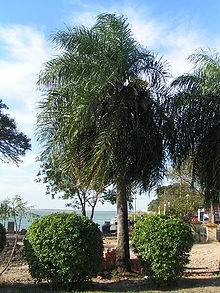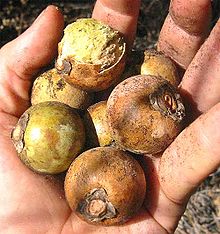- Acrocomia aculeata
-
Acrocomia aculeata 
Scientific classification Kingdom: Plantae (unranked): Angiosperms (unranked): Monocots (unranked): Commelinids Order: Arecales Family: Arecaceae Subfamily: Arecoideae Tribe: Cocoeae Genus: Acrocomia Species: A. aculeata Binomial name Acrocomia aculeata
(Jacq.) Lodd. ex Mart.[1]Acrocomia aculeata is a species of palm native to tropical regions of the Americas, from southern Mexico and the Caribbean south to Paraguay and northern Argentina. Common names include Grugru Palm, Macaúba Palm, Coyol Palm, and Macaw Palm; synonyms include A. lasiospatha, A. sclerocarpa, A. totai, and A. vinifera.
Description
It grows to 15-20 m tall, with a trunk up to 50 cm diameter, characterized by numerous slender, black, viciously sharp 10 cm long spines jutting out from the trunk. The leaves are pinnate, 3-4 m long, with numerous slender, 50-100 cm long leaflets. Petioles of the leaves are also covered with spines. The flowers are small, produced on a large branched inflorescence 1.5 m long. The fruit is a yellowish-green drupe 2.5-5 cm in diameter, containing a single, dark brown, nut-like seed 2.5-5 cm diameter, which is very tough to break. The inside is a dry white filling that has a vaguely sweet taste when eaten.
Uses
The plants inhabit a wide variety of climates and situations; in Paraguay, for example, where it is ubiquitous, it is called the coco paraguayo (Paraguayan coconut), as it is much less common in the rest of the world. It has been suggested that grugru nut, which come in mass numbers from each tree, can be used in the manufacture of biodiesel. The grugru nut, while very hard, can be sliced into thin circles to be sanded and worn as rings. The trunk of the palm can also be 'milked' to yield a fermented alcoholic beverage known as coyol wine.
References
- ^ Martius, Historia Naturalis Palmarum 2:66. 1824
Categories:- Acrocomia
- Flora of Brazil
- Plants described in 1763
Wikimedia Foundation. 2010.

